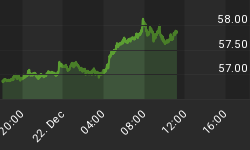A late-day slide on Wednesday, another decline today before stocks bounced from being short-term "oversold" in the eyes of some...and on broadening volume. The S&P closed -0.3% today and is at the year's nadir (so far).
That stocks are declining isn't that surprising, in a sense; they were discounting robust growth and there were many ways reality could fall short of that expectation. It didn't actually require a catalyst, merely gravity. However, there have in fact been catalysts, and the tea leaves have been surprisingly easy to read (so much so that even Wall Street economists are now actually lowering their growth forecasts although those forecasts still appear rosy in my view). Yesterday's ADP was near consensus, but a shade weak. In the current environment, given what was expected, "a shade weak" is going to draw more reaction than "a touch strong," although economically speaking the actual ADP was well within the error bar of the forecast - that is, we can't really discern whether the underlying trend is weakening or not from that data.
But the misses are all starting to add up on the same side. The ECB saw €442bln mature in the 12-month facility, but lent €161bln in 3-month, €198bln in 1-week, and €136bln in 6-day money; in other words, there was net additional borrowing after the "withdrawal" of the 1y lending. Hmmm. Today, Initial Claims came out above expectations at 472k, continuing to bounce around in the range while economists keep forecasting a breakout improvement. ISM Manufacturing was 3 points below expectations, a pretty big miss in that number, and Pending Home Sales were off 30%. Some of this was expected - the expiration of the home buyer credit should of course lead to fewer homes being bought - but again, the misses are all on the same side. To be sure, ISM at 56.2 is still at levels indicating expansion, but vehicle sales were a weak 11.08mm units in June...again on the weak side. I guess I would say there isn't one catalyst, but the data and events are collectively catalytic.
So this is pretty transparent. My main concern is that it has become very easy to be short; since stocks broke back into the 'consolidation zone' and nearly as quickly broke out of it on the low side, there have been almost no reasons for shorts to question their positions. Yet, tomorrow the monthly Employment numbers hit the tape at 8:30 ET (Consensus: -130k, 9.8% Unemployment Rate from 9.7%), and with the Census workers starting to return to the industrial reserve army of the unemployed, there is tremendous variance in the possible numbers tomorrow and several different ways to look at the results. (Personally, I suspect people will focus on the change in private payrolls, which economists forecast - somewhat implausibly, I think - at +110k from +41k). I am suspicious of bearish positions right now, and as I noted a couple of days ago (in the column about the implication of the Kelly criterion for trading) the level of market volatility argues that one should keep risk low whatever your view.
This goes for bonds as well. The uptrend there looks a little more tired today, with TYU0 +2/32nds and the 10y yield down to 2.93%. TIPS weakened sharply with breakevens down 5-10bps. This was partly because the Treasury announced the 10y TIPS auction next week will be $12bln rather than the $11bln most observers seemed to be expecting, but weak crude oil (-$3 today) and gold (-$47) didn't help. I think the market will easily absorb the $12bln, but the auction itself may still be sloppy because dealers don't sound as gung-ho to serve their typical underwrite-and-distribute function for this bond.
Today former Chairman Greenspan was on CNBC. This guy must have the greatest PR machine in the world. His forecasts have been among the world's worst, even when he was actually controlling the policy levers that affected the outcomes. And yet, he still gets on CNBC and in the papers with regularity. It's astonishing. Today he shared the brilliant insight that this is just a "typical pause" in the recovery due to a "short-term fear factor" that keeps employers from hiring. Seriously, in what way has anything about the last few years been "typical"?















